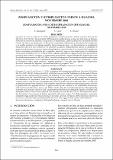Por favor, use este identificador para citar o enlazar este ítem:
https://hdl.handle.net/20.500.12958/7767Registro completo de metadatos
| Campo DC | Valor | Lengua/Idioma |
|---|---|---|
| dc.contributor.author | Quesquén, Roberto | - |
| dc.contributor.author | Ayón Dejo, Patricia | - |
| dc.contributor.author | Orosco, Ximena | - |
| dc.date.accessioned | 2023-07-06T16:08:27Z | - |
| dc.date.available | 2023-07-06T16:08:27Z | - |
| dc.date.issued | 2023-06 | - |
| dc.identifier.citation | Quesquén, R., Ayón, P. y Orosco, X. (2023). Zooplancton e ictioplancton frente a Huacho, noviembre 2018. Inf Inst Mar Perú, 50(2), 240-247. | es_ES |
| dc.identifier.issn | 0378-7702 | - |
| dc.identifier.uri | https://hdl.handle.net/20.500.12958/7767 | - |
| dc.description.abstract | En noviembre 2018 durante el estudio de línea de base del área piloto de Huacho, elaborado en el marco del proyecto: “Adaptación a los Impactos del Cambio Climático en el Ecosistema Marino Costero del Perú y sus Pesquerías”, se determinó composición, distribución y abundancia del zooplancton y su posible asociación con algunas variables físicas (masas de agua). Los biovolúmenes de zooplancton fluctuaron entre 3,8 y 241,7 mL/100 m3. Se determinó 23 grupos zooplanctónicos, siendo los copépodos el grupo más abundante y frecuente, seguido de poliquetos y apendicularias. La comunidad del zooplancton estuvo compuesta principalmente por copépodos, siendo las especies más importantes por abundancia Acartia tonsa, Paracalanus parvus y Oithona similis. Especies indicadoras de aguas costeras frías prevalecieron en toda el área evaluada; asimismo, se observó especies asociadas a Aguas Subtropicales Superficiales cuyas densidades fueron menores a 800 Ind./100 m3, describiendo dos grupos de estaciones asociados con las masas de agua. El ictioplancton estuvo representado por huevos y larvas de Engraulis ringens “anchoveta” y larvas de Leuroglossus stilbius (antes urotranus) “esperlán plateado”, Odontesthes regia “pejerrey” y Diogenichthys laternatus “linternilla de Diógenes”, así como huevos de Mugil cephalus “lisa”. | es_ES |
| dc.description.abstract | ABSTRACT: In November 2018, within the framework of the “Adaptation to the Impacts of Climate Change on the Coastal Marine Ecosystem and Fisheries of Peru” project, a comprehensive baseline study was carried out in the Huacho Pilot Area. The primary objective was to assess the composition, distribution, and abundance of zooplankton, while also investigating their potential correlation with various physical variables such as water masses. Zooplankton biovolumes ranged from 3.8 to 241.7 mL/100 m3. A total of 23 zooplankton groups were identified, with copepods being the most abundant and frequent group, followed by polychaetes and appendicularians. Copepods made up the majority of the zooplankton community, with Acartia tonsa, Paracalanus parvus, and Oithona similis being the most abundant species. Throughout the evaluated area, indicator species of cold coastal waters predominated. Additionally, species associated with Subtropical Surface Waters were observed, with densities less than 800 Ind./100 m3. This observation led to the description of two groups of stations associated with water masses. The ichthyoplankton community consisted of eggs and larvae of Engraulis ringens as well as larvae of Leuroglossus stilbius (previously known as urotranus), Odontesthes regia, and Diogenichthys laternatus. Also, eggs of Mugil cephalus were observed. | - |
| dc.language | spa | - |
| dc.language.iso | spa | es_ES |
| dc.publisher | Instituto del Mar del Perú | es_ES |
| dc.relation.ispartofseries | Informe IMARPE 50(2), 2023; | - |
| dc.rights | info:eu-repo/semantics/openAccess | es_ES |
| dc.rights.uri | https://creativecommons.org/licenses/by/4.0/ | es_ES |
| dc.source | Instituto del Mar del Perú - IMARPE | es_ES |
| dc.source.uri | Repositorio Digital IMARPE | es_ES |
| dc.subject | Biovolúmenes | es_ES |
| dc.subject | Zooplancton | es_ES |
| dc.subject | Indicadores biológicos | es_ES |
| dc.subject | Anchoveta | es_ES |
| dc.subject | Huacho | es_ES |
| dc.title | Zooplancton e ictioplancton frente a Huacho, noviembre 2018 | es_ES |
| dc.title.alternative | Zooplankton and ichthyoplankton off Huacho, November 2018 | es_ES |
| dc.type | info:eu-repo/semantics/article | es_ES |
| dc.publisher.country | Perú - Callao | es_ES |
| dc.subject.ocde | http://purl.org/pe-repo/ocde/ford#1.05.11 | es_ES |
| Aparece en las colecciones: | Informe vol. 50(2) 2023 | |
Ficheros en este ítem:
| Fichero | Descripción | Tamaño | Formato | |
|---|---|---|---|---|
| Informe 50(2) Articulo 10.pdf | 666,9 kB | Adobe PDF |  Visualizar/Abrir |
Este ítem está sujeto a una licencia Creative Commons Licencia Creative Commons

